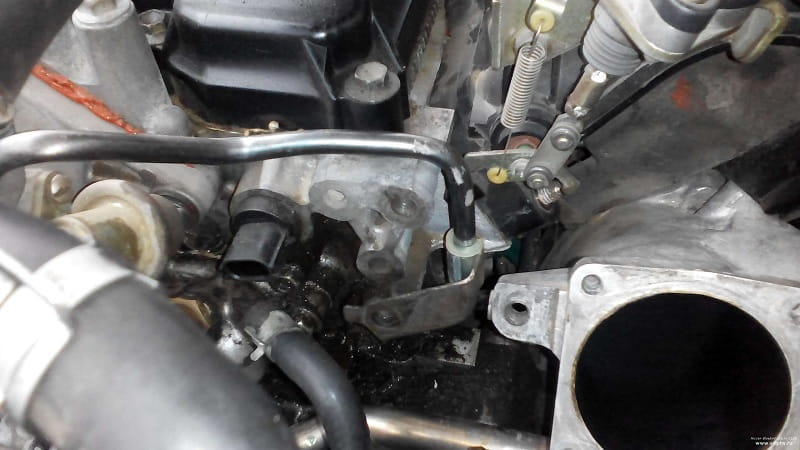This post contains affiliate links. This means I will make a commission at no extra cost to you should you click through and make a purchase [ “As an Amazon Associate, I earn from qualifying purchases.” ]. Read the full disclosure here.
Understanding P0086: Exhaust Valve Control Solenoid Circuit High (Bank 2) GuideMechanic.Com In the modern automotive era, the integration of intricate electronic systems has become paramount for engine performance and efficiency.
However, alongside these advancements comes the challenge of diagnosing and addressing issues indicated by diagnostic trouble codes (DTCs).
One such code is P0086, which specifically points to a problem in the exhaust valve control solenoid circuit high in Bank 2.
In this comprehensive article, we’ll delve into the intricacies of P0086, unravel its implications, explore potential causes, and discuss diagnostic procedures along with effective remedies to rectify this issue.
P0086 Exhaust Valve Control Solenoid Circuit High (Bank 2)
Understanding P0086:

P0086 is an OBD-II trouble code that signifies a high voltage condition in the exhaust valve control solenoid circuit of Bank 2.
Within engines equipped with variable valve timing (VVT), the exhaust valve control solenoid regulates the timing of the exhaust valves, optimizing engine performance under varying operating conditions.
Bank 2 refers to the bank of cylinders opposite to Bank 1 in V-engine configurations, commonly found in V6, V8, and other multi-cylinder engines.
Causes of P0086:
See Also: P0087 Fuel Rail/System Pressure – Too Low
Several factors can contribute to the occurrence of the P0086 error code:
Faulty Exhaust Valve Control Solenoid: A malfunctioning or defective exhaust valve control solenoid can result in irregularities in the circuit’s voltage, causing a high voltage condition and triggering the P0086 code.
Wiring Issues: Damage, corrosion, or poor connections within the wiring harness connecting the exhaust valve control solenoid to the engine control module (ECM) can disrupt electrical signals, leading to a high voltage condition in the circuit.
Excessive Voltage Supply: Higher-than-normal voltage supply from the vehicle’s battery or alternator can cause high voltage in the exhaust valve control solenoid circuit, prompting the ECM to set the P0086 code.
Engine Oil Contamination: Contaminated or degraded engine oil can hinder the proper operation of the VVT system, affecting the performance of the exhaust valve control solenoid and potentially leading to the detection of the P0086 fault code.
ECM Malfunction: A malfunctioning engine control module may misinterpret signals from the exhaust valve control solenoid circuit, erroneously detecting a high voltage condition and setting the P0086 code.
P0086 Exhaust Valve Control Solenoid Circuit High (Bank 2)
Diagnosing P0086:
Diagnosing the root cause of the P0086 code requires a systematic approach:
OBD-II Scan: Utilize an OBD-II scanner to retrieve the stored trouble codes, including P0086. Analyze accompanying freeze frame data to gain insights into the conditions present when the fault occurred.
Visual Inspection: Conduct a visual inspection of the exhaust valve control solenoid, its wiring harness, and connectors. Look for signs of damage, corrosion, or loose connections. Repair or replace components as needed.
Solenoid Operation Test: Employ a multimeter to test the resistance of the exhaust valve control solenoid according to manufacturer specifications. Additionally, verify proper voltage and ground signals when the engine is running.
Battery Voltage Check: Measure the voltage output of the vehicle’s battery and alternator to ensure they are operating within the manufacturer’s specified range. Excessive battery voltage can contribute to a high voltage condition in the exhaust valve control solenoid circuit, triggering the P0086 code.
Engine Oil Examination: Inspect the engine oil level and condition. Ensure that the oil is clean, at the correct level, and meets the manufacturer’s specifications. Contaminated or low-quality oil can impair the operation of the VVT system and lead to fault codes like P0086.
Rectifying P0086:
Once the underlying cause of the P0086 code has been identified, appropriate measures can be taken to address the issue:
Replace Faulty Components: If the exhaust valve control solenoid or wiring is found to be defective, replace them with genuine OEM parts to restore proper functionality.
Repair Wiring: Repair any damaged or corroded wiring in the exhaust valve control solenoid circuit, ensuring secure connections and proper insulation to prevent future issues.
Voltage Regulation: Implement measures to regulate voltage supply from the vehicle’s battery or alternator, such as installing a voltage regulator or replacing faulty components.
Engine Oil Change: If engine oil contamination is determined to be a contributing factor, perform an oil change using the manufacturer’s recommended oil grade and viscosity. Regular oil changes at specified intervals help maintain optimal engine performance.
Reset ECM: After addressing the root cause of the P0086 code, use an OBD-II scanner to clear the trouble codes and reset the engine control module. This allows the ECM to relearn corrected parameters and monitor system operation for any further issues.
P0086 Exhaust Valve Control Solenoid Circuit High (Bank 2)
Conclusion:
The P0086 error code related to the exhaust valve control solenoid circuit high in Bank 2 signifies potential issues within the vehicle’s VVT system.
By understanding the causes, conducting systematic diagnostics, and implementing appropriate corrective actions, vehicle owners and technicians can effectively resolve this issue and restore proper engine performance.
Regular maintenance and prompt attention to warning signs are key to preventing the recurrence of such issues, ensuring continued reliability and efficiency of the vehicle’s engine.
- Seafoam Catalytic Converter Cleaner: It Work & How to Use It? - April 18, 2025
- Rislone Catalytic Converter Cleaner: What It Is, How It Works - April 18, 2025
- Wynn’s Catalytic Converter Cleaner 325ml - April 17, 2025
